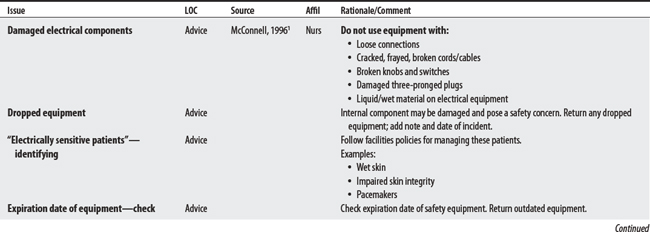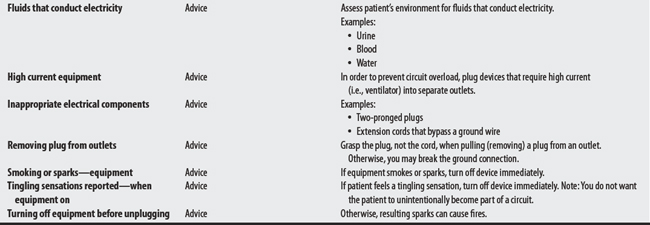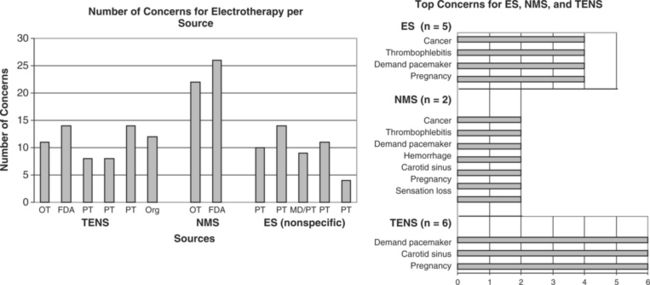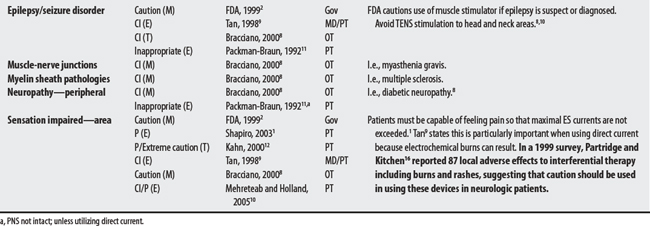Chapter 41 Electrical Stimulation
41.2 Electrical Stimulation
(TRANSCUTANEOUS ELECTRICAL NERVE STIMULATION [TENS]; NEUROMUSCULAR ELECTRICAL STIMULATION)
OVERVIEW.
Electrical stimulation (ES) uses alternating or direct current to accomplish various therapeutic aims including (1) to increase strength and endurance of innervated muscle (NMES), (2) to modulate pain (TENS), (3) to reduce edema (HVPC) and enhance healing, and (4) to stimulate denervated muscle (DC). It is also used (5) to deliver transdermal drugs using direct current (see Iontophoresis) and (6) to activate muscles during functional activities (see Functional electrical stimulation).1
The literature tends to treat electrical stimulation either in general terms, or alternatively, addresses motor (NEMS, or powered muscle stimulator) and pain modulation (TENS) modality concerns separately (as the FDA does).2,3 In this text, I differentiate among NMES, ES, and TENS concerns.
GUIDELINE SIMILARITIES AND DIFFERENCES.
NEMS, ES, and TENS shared some concerns: demand pacemakers, pregnancy, and treatments over the carotid sinus. On the other hand, modality-specific concerns were also apparent in this sample. For example, TENS had distinct concerns for undiagnosed pain, suppression of protective sensory mechanisms, and narcotic/drug use. This would make sense because TENS is used primarily for pain control. Also noteworthy, procedural concerns appear more common during TENS use (17 procedural concerns) than for NEMS (6 procedural concerns). In contrast, NEMS guidelines contain more motion-related concerns such as thrombophlebitis, fractures, hemorrhaging, the operation of machinery (e.g., driving), and conditions where movement is contraindicated. Again, this seems logical, in that NEMS affects muscle contraction.
OTHER ISSUES.
(1) Cross-infection: In a 2000 laboratory-based study, Lambert et al4 sampled microorganisms on suction cups and sponges used during interferential therapy and demonstrated the possibility of cross infection in a healthy volunteer. (2) Partially denervated muscle and direct current: In a 1979 Nature publication, Brown and Holland5 reported that direct current interfered with sprouting in partially denervated muscle. In a critique, one source1 argued that the parameters used in Brown and Holland’s study were unlike those used in patients treated with denervated muscle. (3) Brachial plexus injury: In 1986, Mubarak and Wyatt6 reported a 13-year-old white girl with idiopathic scoliosis who received electrical stimulation to the trunk for scoliosis and subsequently experienced upper/middle brachial plexus injury possibly from stimulus-related shoulder girdle hyperextension near the thoracic outlet. (4) RA: In 1981, Griffin and McClure7 reported a 43-year-old female with RA who experienced a possible circulatory-related exacerbation of her symptoms following TENS use.
CONTRAINDICATIONS AND PRECAUTIONS
A00-B99 CERTAIN INFECTIONS AND PARASITIC DISEASES
D50-D89 DISEASES OF BLOOD AND BLOOD-FORMING ORGANS AND CERTAIN DISORERS
E00-E90 ENDOCRINE, NUTRITIONAL, AND METABOLIC DISEASES
F00-F99 MENTAL AND BEHAVIORAL DISORDERS
G00-G99 DISEASES OF THE NERVOUS SYSTEM
I00-I99 DISEASES OF THE CIRCULATORY SYSTEM
L00-L99 DISEASES OF THE SKIN AND SUBCUTANEOUS TISSUE
N00-N99 DISEASES OF THE GENITOURINARY SYSTEM
< div class='tao-gold-member'>
Stay updated, free articles. Join our Telegram channel

Full access? Get Clinical Tree





















